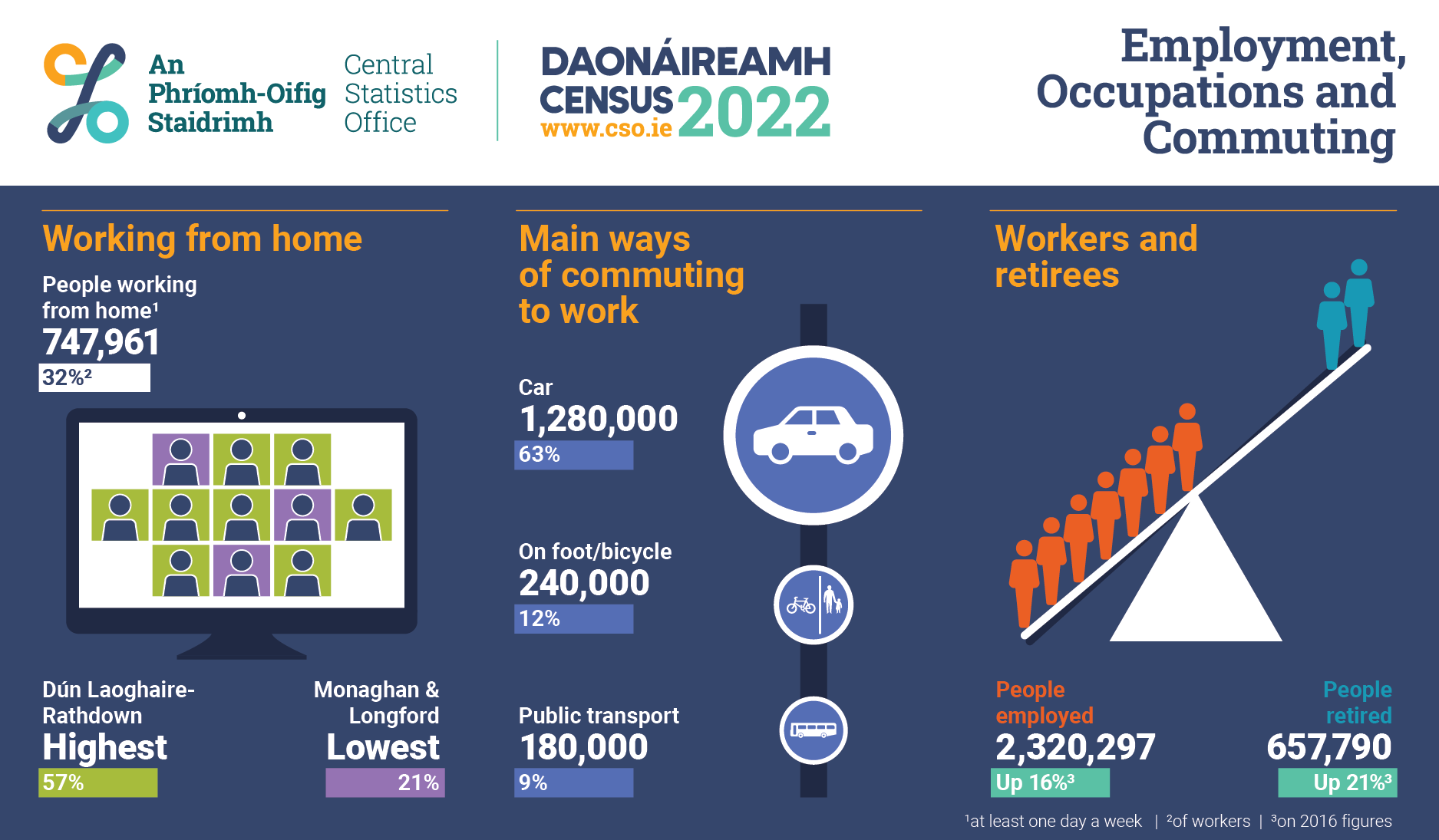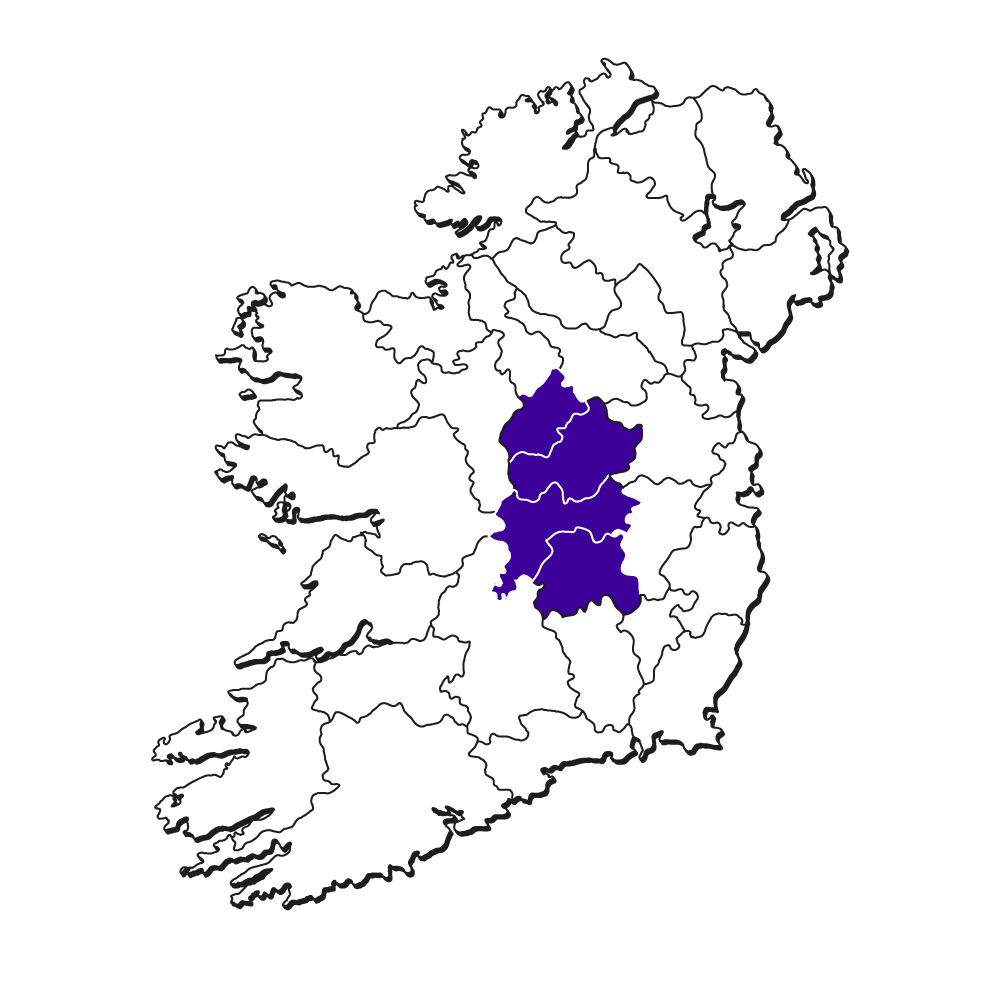The Central Statistics Office (CSO) has released Census 2022 Profile 7 – Employment, Occupations and Commuting. Here are highlights of some of the main results for Laois, Offaly, Westmeath and Longford. The publication focuses on people at work, unemployed, and outside the labour force, occupations and main sectors of employment, as well as on the commuting patterns of workers, students, and children at school or childcare.
Key Findings
- The number of workers in all counties rose with the largest percentage increase recorded in Longford, up 30% since 2016.
- The counties with the highest unemployment rates were Louth, Longford, and Donegal, all at 11%.
- Commuters in Laois were travelling for an average distance of 25.3km, the longest in the country.
- Longford, along with Monaghan, the lowest rate in the country likely to work from home
- Manufacturing and the Wholesale and Trade Sector accounts for the largest amount of workers in the midlands region

Midlands Statistics
Longford
People at Work/Unemployed
More than 37,000 people living in the county in April 2022 were aged 15 and over and of these almost 19,700 people were at work. This was an increase of 30% (from the almost 15,200 people recorded as working in Census 2016) – the highest rate of increase in the country.
There were 19,695 people (aged 15 and over) at work in Longford, an increase of 4,523 people (+30%) between 2016 and 2022.
Almost 2,400 people were unemployed in the county in April 2022. This was considerably lower than the 2016 figure of more than 3,700 people (a decrease of 36%). The unemployment rate was 11% compared with 20% in 2016. This was the joint highest rate in the country
Where people worked
Manufacturing accounted for the largest number of workers in the county at almost 3,000. The Wholesale and Retail Trade sector was the next largest, with nearly 2,200 workers followed by Human Health and Social Work Activities with almost 1,900 workers.

Working From Home
There were nearly 19,700 people at work in Longford in April 2022. Of these, almost 11,800 never worked from home while more than 4,100 people worked from home at least some of the time. Workers in the county, along with those in Monaghan, were the least likely to work from, with 21% doing so. Of those working from home in Longford, almost 1,000 people did so for five days per week, with 686 doing so for two days and 678 for one day each week.
Travelling to Work
There were 17,779 people travelling to work in the county in April 2022. The majority of these drove to work, with 10,427 people driving to work by car in 2022. There were 230 people travelling by bus and 153 by train. Looking at active travel, 1,246 people walked to work, up from 1,193 in 2016, while 237 people cycled, an increase of 93 people since 2016.
Commuters in the county were travelling for longer in April 2022, with an average journey time of 28.8 minutes compared with 26.4 minutes in 2016. Nationally, the average journey time increased from 28.2 minutes to 29.1 minutes between 2016 and 2022. There were 4,680 Longford commuters who had a journey time of less than 15 minutes, while 4,243 people had a journey time of 15 to 30 minutes. A further 1,919 people had a journey time of 60 minutes and over.
Offaly
People at Work/Unemployed
Almost 66,000 people living in the county in April 2022 were aged 15 and over and of these more than 35,200 people were at work. This was an increase of 16% (from the almost 30,300 people recorded as working in Census 2016).
Almost 3,700 people were unemployed in the county in April 2022. This was considerably lower than the 2016 figure of more than 5,700 people (a decrease of 36%).
The labour force participation rate was 59% in Offaly compared with 61% nationally. Among females the rate was 52% while for males it was 66%. Nationally the trend was similar at 56% for female labour force participation and 67% for males.
Most people in work in Offaly were in full-time employment, with over 26,600 people in this category, compared with just over 5,100 who were working part-time.

Where people worked
The Manufacturing sector accounted for the largest number of workers in the county at over 4,600. Wholesale and Retail Trade was the next largest, with almost 4,600 workers followed by Human Health and Social Work Activities with more than 4,300 workers.
Working From Home
There were more than 35,200 people at work in Offaly in April 2022. Of these, almost 23,200 never worked from home, while more than 8,300 people worked from home at least some of the time.
Travelling to Work
There were 32,065 people travelling to work in the county in April 2022. The majority of these drove to work, with 21,143 people driving to work by car in 2022. There were 441 people travelling by bus, and 391 by train. Looking at active travel, 2,367 people walked to work, up from 2,097 in 2016, while 504 people cycled, an increase of 95 people since 2016.
Commuters in the county were travelling for longer in April 2022, with an average journey time of 30.2 minutes compared with 28.9 minutes in 2016. Nationally, the average journey time increased from 28.2 minutes to 29.1 minutes between 2016 and 2022. There were 8,828 Offaly commuters who had a journey time of less than 15 minutes, while 7,857 people had a journey time of 15 to 30 minutes. A further 4,769 people had a journey time of 60 minutes and over.
Westmeath
People at Work/Unemployed
More than 76,400 people living in the county in April 2022 were aged 15 and over and of these almost 42,100 people were at work. This was an increase of 19% (from the almost 35,300 people recorded as working in Census 2016).
More than 4,400 people were unemployed in the county in April 2022. This was considerably lower than the 2016 figure of almost 6,700 people (a decrease of 34%).
The labour force participation rate was 61% in Westmeath, the same as the national figure. Among females the rate was 55% while for males it was 67%. Nationally the trend was similar at 56% for female labour force participation and 67% for males.
Most people in work in Westmeath were in full-time employment, with nearly 31,200 people in this category, compared with over 5,900 who were working part-time.
Where people worked
The Wholesale and Retail Trade sector accounted for the largest number of workers in the county at almost 5,400. Human Health and Social Work Activities was the next largest, with just over 5,100 workers followed by Manufacturing with more than 4,500 workers.

Working From Home
There were more than 42,100 people at work in Westmeath in April 2022. Of these, over 25,800 never worked from home, while more than 5,100 people worked from home at least some of the time.
Travelling to Work
There were 37,866 people travelling to work in the county in April 2022. The majority of these drove to work, with 24,378 people driving to work by car in 2022. There were 893 people travelling by bus and 339 by train. Looking at active travel, 2,897 people walked to work, up from 2,788 in 2016, while 518 people cycled, an increase of 47 people since 2016.
Commuters in the county were travelling for longer in April 2022, with an average journey time of 30.4 minutes compared with 28.8 minutes in 2016. Nationally, the average journey time increased from 28.2 minutes to 29.1 minutes between 2016 and 2022. There were 9,896 Westmeath commuters who had a journey time of less than 15 minutes, while 9,929 people had a journey time of 15 to 30 minutes. A further 5,962 people had a journey time of 60 min

Laois
People at Work/Unemployed
Almost 71,500 people living in the county in April 2022 were aged 15 and over and of these almost 40,000 people were at work. This was an increase of 19% (from the more than 33,500 people recorded as working in Census 2016).
Almost 3,900 people were unemployed in the county in April 2022. This was considerably lower than the 2016 figure of almost 6,100 people (a decrease of 36%). The unemployment rate was 9% compared with 15% in 2016.
The labour force participation rate was 61% in Laois which was the same as the figure nationally. Among females the rate was 55% while for males it was 68%. Nationally the trend was similar at 56% for female labour force participation and 67% for males.
Most people in work in Laois were in full-time employment, with more than 30,100 people in this category, compared with almost 5,700 who were working part-time.
Where people worked
The Wholesale and Retail Trade sector accounted for the largest number of workers in the county at almost 5,600. Human Health and Social Work Activities was the next largest, with just over 4,900 workers followed by Education with almost 3,700 workers.

Working From Home
There were almost 40,000 people at work in Laois in April 2022. Of these, over 25,600 never worked from home while almost 10,100 people worked from home at least some of the time. Of those working from home, more than 2,100 people did so for five days per week, with 1,786 doing so for two days and 1,767 for one day each week.
Travelling to Work
There were 36,189 people travelling to work in the county in April 2022. The majority of these drove to work, with 23,944 people driving to work by car in 2022. There were 818 people travelling by train and 579 by bus. Looking at active travel, 2,073 people walked to work, up from 1,883 in 2016, while 367 people cycled, an increase of 121 people since 2016.
Commuters in the county were travelling for longer in April 2022, with an average journey time of 32.3 minutes compared with 31.9 minutes in 2016. Nationally, the average journey time increased from 28.2 minutes to 29.1 minutes between 2016 and 2022. There were 8,575 Laois commuters who had a journey time of less than 15 minutes, while 9,096 people had a journey time of 15 to 30 minutes. A further 6,221 people had a journey time of 60 minutes and over.
Commuters in the county were travelling for an average distance of 25.3km, the longest in the country. The average distance nationally was 16.8km.
Commenting on the results, Dr Tracy Clegg, Statistician in the Census Division, said:
“Profile 7 provides detailed analysis on the information published in May 2023 in the Employment, Occupation, Industry and Commuting Chapter of the Census 2022 Summary Results. The addition of new questions in Census 2022 on topics such as commuting to childcare, part-time working, working from home, and the time people left their workplace, school, college or childcare means we can provide more insight on travel patterns. For a national picture of the results, look here Census 2022.






